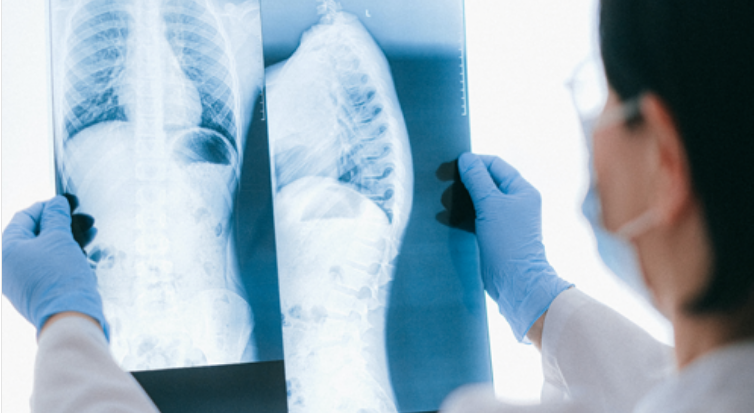Assessing the Prognostic Utility of Clinical & Radiomic Features for COVID-19 Patients Admitted to ICU: Challenges & Lessons Learned

Yi Li, Professor of Biostatistics, and his lab team have collaborated on building an analytic workflow for creating ensemble prediction models with clinical and imaging data; their motivation was ICU mortality among patients with COVID-19. The results of this project are highlighted in a new publication in the Harvard Data Science Review; authors include Yuming Sun (a former student of Li Lab and now at William & Mary), Stephen Salerno (a former student of Li Lab and now at Fred Hutchinson Cancer center), Professor Jiang Kang, members Donglin Zeng and Dr. Li of course! The authors also include their collaborators from Harvard University. Learn more about their experience, the insights gained, and what’s next:
- Briefly, what was the aim of this project at the outset?
Our collaborative efforts with Michigan Medicine in monitoring patient outcomes within the ICU have motivated us to investigate the potential advantages of incorporating clinical information and chest X-ray images for predicting patient outcomes. This experience has enabled us to scrutinize the benefits of using both radiomic features and clinical information when building predictive models. In this work, we focus on formalizing the task of prediction in settings where readily available radiomic data, such as images taken via portable chest X-ray, may supplement clinical information which would be taken during an extended history and physical examination, that may be unavailable in emergent or critical care settings. We propose an analytical workflow to address challenges such as the absence of standardized approaches for image pre-processing and data utilization. We then propose an ensemble learning approach designed to maximize the information derived from multiple prediction algorithms.
- How did Precision Health resources, tools and data contribute to the ultimate project outcomes?
This rich database provides health and geolocation data of more than 4 million Michigan Medicine patients, as well as an imaging data repository of more than 750,000 chest X-rays for 100,000+ patients, genetic testing results, and patient-reported survey data. As part of the Precision Health Initiative, Michigan Medicine has collected X-ray images from inpatient settings, including those patients with COVID-19. With access to the EHR and X-ray data from these sources via DataDirect, we have been in a unique position to develop new methodologies for identifying patient characteristics, clinical factors, and radiomic features linked to COVID-19 status, disease severity, and survival outcomes, and to evaluate the efficacy of ensemble learning methods for COVID-19 patient risk stratification and prognostication.
- How did your team experience Precision Health tools, data & resources?
Owing to the wealth of data available through DataDirect and its ease of use, we were able to extract and create a set of demographic, socioeconomic, and clinical risk factors which have previously been identified as being related to COVID-19 in the literature and link them to raw images taken from radiomic studies. This allowed us to create a comprehensive, multi-modal analytic dataset from which we could select and analyze relevant clinical imaging features based on patient survival information.
- What were your most salient findings on this project? Are there next steps or further questions this research has inspired?
This work presents an analytic workflow for combining clinical, socio-demographic, and radiomic risk factors for COVID-19 mortality after escalation to an intensive care setting. We applied this workflow and our refined ensemble prediction methodology to analyze post-ICU COVID-19 mortality, an occurrence observed in 21% of COVID-19 patients admitted to the ICU at Michigan Medicine. Our findings reveal substantial performance improvement when incorporating imaging data compared to models trained solely on clinical risk factors. Furthermore, the addition of radiomic features yields even larger enhancements, particularly among older and more medically compromised patients. These results may carry implications for enhancing patient outcomes in similar clinical contexts. This demonstrates the additional prognostic benefits of incorporating imaging information into various prediction models, particularly among certain vulnerable patient sub-populations. In the future, we would like to extend these methods to handle longitudinal data, which may better quantify changes in a patient’s clinical course, informing therapeutic decisions.
- Based on your experience with Precision Health resources on this project, will you look to Precision Health in the future for support on other studies?
Our results are supported by a growing body of literature, our previous experience working with data on COVID-19 patients at Michigan Medicine, and especially the resources available to us through DataDirect. We believe the DataDirect COVID-19 clinical data and X-ray databases are crucial parts of the Precision Health Initiative established during the pandemic, and its infrastructure has provided an invaluable platform for facilitating our work. We will continue to work with Precision Health on future studies, leveraging this detailed patient information to provide insights into the lingering impact of the pandemic and inform the long-term management of patients recovering from COVID-19.
Read the Harvard Data Science Review article here: Assessing the Prognostic Utility of Clinical and Radiomic Features for COVID-19 Patients Admitted to ICU: Challenges and Lessons Learned · Harvard Data Science Review


